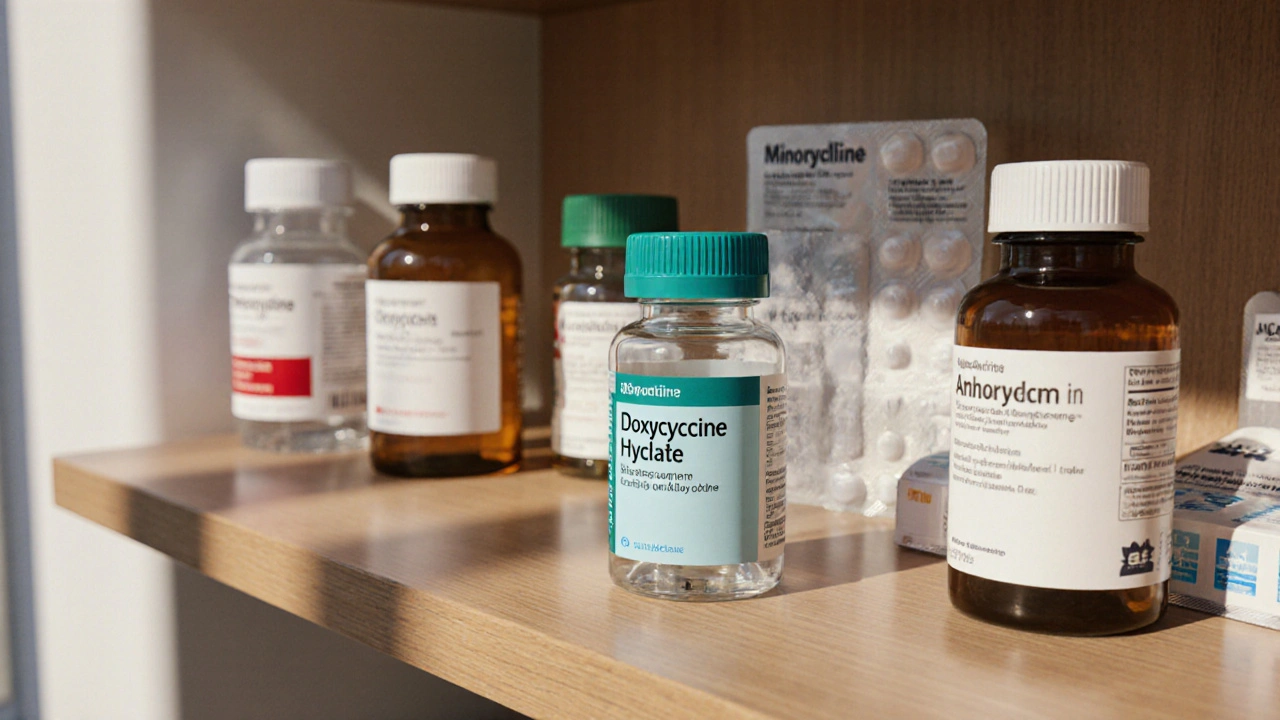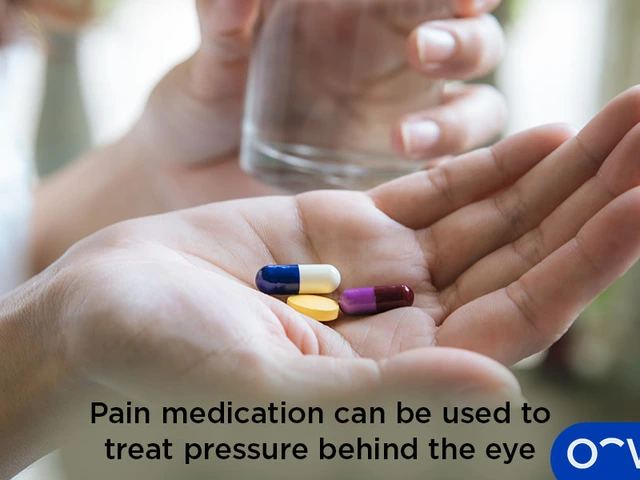Antibiotic Choice Guide
Select a condition and side effect concern to see recommendations.
Comparison Table
| Drug | GI Upset | Photosensitivity | Rare Serious Effects |
|---|
Key Points
Select a condition to view key points about antibiotic effectiveness.
When you or a loved one need an antibiotic, the name Doxycycline alternatives often pops up in forums and pharmacy chats. Doxycycline Hyclate is a popular prescription, but is it the right choice for every infection? This guide breaks down the key differences, shows where each drug shines, and helps you decide which option fits your health situation.
What is Doxycycline Hyclate?
Doxycycline Hyclate is a broad‑spectrum tetracycline antibiotic that works by stopping bacteria from making proteins they need to grow. First approved in the 1960s, the hyclate salt form improves water solubility, making tablets easier to swallow. Typical dosing ranges from 100mg once daily for acne to 200mg daily for respiratory infections. Its half‑life of about 18hours allows once‑or‑twice‑daily dosing, which many patients appreciate.
Common Alternatives and Their Core Traits
- Tetracycline - the older sibling of doxycycline, less potent, requires four daily doses and has higher gastrointestinal upset.
- Minocycline - a newer tetracycline with better tissue penetration, frequently used for severe acne and rheumatoid arthritis.
- Azithromycin - a macrolide that offers a short 3‑day course, popular for community‑acquired pneumonia and sexually transmitted infections.
- Amoxicillin - a penicillin‑type beta‑lactam, first‑line for ear, throat, and urinary tract infections.
- Clindamycin - a lincosamide useful for anaerobic infections and skin‑soft tissue infections when penicillin allergies exist.
- Levofloxacin - a fluoroquinolone with excellent lung penetration, reserved for more serious respiratory infections.
How to Choose the Right Antibiotic - Decision Criteria
- Infection type - Some drugs target specific bacteria better. For example, amoxicillin works well against Streptococcus, while doxycycline covers atypical organisms like Mycoplasma.
- Resistance patterns - Local antibiograms (hospital data) show which bugs are resistant. Doxycycline retains activity against many resistant strains of Borrelia burgdorferi (Lyme disease).
- Dosing convenience - Once‑daily regimens (doxycycline, azithromycin) improve adherence compared to four‑times‑daily drugs (tetracycline).
- Side‑effect profile - Gastrointestinal upset, photosensitivity, and rare liver toxicity vary across agents. Minocycline, for instance, may cause vestibular issues.
- Patient factors - Age, pregnancy status, and existing liver or kidney disease shape the choice. Amoxicillin is safe in pregnancy; doxycycline is contraindicated in the second and third trimesters.

Side‑Effect Snapshot
| Drug | GI Upset | Photosensitivity | Rare Serious Effects |
|---|---|---|---|
| Doxycycline Hyclate | Mild‑moderate nausea (10‑15%) | High (20‑30%) | Esophagitis, hepatic toxicity (very rare) |
| Tetracycline | Higher incidence (20‑25%) | Moderate | Hepatotoxicity (rare) |
| Minocycline | Similar to doxycycline | Low | Autoimmune hepatitis, vestibular dysfunction |
| Azithromycin | Low | Low | QT prolongation (in patients with cardiac risk) |
| Amoxicillin | Low‑moderate | Negligible | Allergic anaphylaxis (≈1%) |
| Clindamycin | Low | Negligible | Clostridioides difficile colitis (significant risk) |
| Levofloxacin | Low‑moderate | Low | Tendon rupture, QT prolongation |
Effectiveness for Specific Conditions
Below is a quick look at how each drug stacks up for three common indications: acne, respiratory infection, and Lyme disease.
| Condition | Best‑Proven Choice | Why It Works |
|---|---|---|
| Acne (moderate‑severe) | Minocycline | Higher lipophilicity reaches skin sebaceous glands more efficiently |
| Community‑acquired pneumonia | Levofloxacin or Azithromycin | Excellent lung tissue penetration and activity against atypicals |
| Lyme disease (early disseminated) | Doxycycline Hyclate | Covers Borrelia burgdorferi and penetrates the central nervous system |
Cost and Availability in the UK (2025)
Price matters, especially if you’re buying from a private pharmacy. Here's an average snapshot (GBP) for a 14‑day course:
- Doxycycline Hyclate - £6.20 (generic tablets)
- Tetracycline - £4.80 (generic)
- Minocycline - £9.50 (brand‑name or generic capsule)
- Azithromycin - £7.00 (single 500mg tablet)
- Amoxicillin - £3.60 (generic 500mg)
- Clindamycin - £8.30 (generic)
- Levofloxacin - £12.40 (generic 500mg)
All listed drugs are available on prescription from NHS clinics, but private pharmacies often stock the generic versions at slightly lower prices.

Quick Takeaways
- Doxycycline Hyclate offers a balanced mix of broad coverage, once‑daily dosing, and low cost - ideal for Lyme disease, atypical pneumonia, and moderate acne.
- Minocycline beats doxycycline for severe, cystic acne thanks to better skin penetration, but carries a higher risk of rare autoimmune side effects.
- Azithromycin shines when you need a short course (3 days) and want to avoid gastrointestinal upset.
- Amoxicillin remains the go‑to for common ear, throat, and urinary infections, especially in children and pregnant women.
- For high‑risk respiratory infections, levofloxacin provides strong efficacy but requires caution due to tendon and heart rhythm concerns.
Practical Tips for Patients
- Take doxycycline with a full glass of water and stay upright for at least 30 minutes to prevent esophageal irritation.
- If you’re prone to sunburn, apply SPF30+ sunscreen daily while on doxycycline or minocycline.
- Inform your GP about any history of liver disease, as older tetracyclines may need dose adjustments.
- Never share antibiotics - resistance spreads when drugs are misused.
- Complete the full prescribed course, even if symptoms improve early, to avoid relapse.
Frequently Asked Questions
Can I take doxycycline if I’m pregnant?
No. Doxycycline is classified as pregnancy category D in the UK, meaning it can cause fetal tooth discoloration and bone growth issues during the second and third trimesters. Safer alternatives like amoxicillin or azithromycin are preferred.
Why does doxycycline cause photosensitivity?
Doxycycline absorbs UV light, forming reactive molecules that damage skin cells. This is why patients are advised to avoid prolonged sun exposure and use high‑SPF sunscreen.
Is minocycline better than doxycycline for acne?
For severe nodular acne, minocycline often works faster because it reaches the skin’s sebaceous glands more effectively. However, it carries a higher risk of rare autoimmune hepatitis, so doctors weigh benefits against risks.
Can I switch from doxycycline to azithromycin mid‑course?
Switching is possible but should be guided by a clinician. The two drugs target different bacterial families; an abrupt change may leave some pathogens untreated and encourage resistance.
What should I do if I develop severe stomach pain while on doxycycline?
Stop the medication and contact your GP immediately. Severe abdominal pain could signal ulceration or esophagitis, especially if the pill isn’t taken with enough water.





Geneva Lyra - 7 October 2025
Hey everyone! This guide is super helpful-especially for folks who are new to picking antibiotics. I love how it breaks down the side‑effects in a clear table, and the cost info is a nice touch for us budget‑conscious patients. Remember to stay hydrated when you take doxycycline, it can be a bit harsh on the esophagus. Also, if you’re planning a beach vacay, don’t forget sunscreen; the photosensitivity thing is real! 😊
Moritz Bender - 7 October 2025
From a pharmacokinetic standpoint, doxycycline’s lipophilicity (logP ≈ 2.7) facilitates transcellular diffusion across the gastrointestinal mucosa, thereby enhancing systemic bioavailability (≈95%). The acid‑stable formulation mitigates degradation in gastric pH, which is why we advise ingestion with a full glass of water and an upright posture to avert esophagus irritation. Moreover, its half‑life (~18 h) supports once‑daily dosing, optimizing patient adherence. 📊
Nicole Hernandez - 7 October 2025
Indeed, the pharmacologic profile you outlined underscores the practicality of doxycycline for a wide spectrum of infections, from atypical pneumonia to early disseminated Lyme disease. Clinicians appreciate the balance between efficacy and tolerability, especially when counseling patients who are apprehensive about medication side‑effects. By integrating these considerations into shared decision‑making, we empower patients to adhere to therapy and achieve optimal outcomes.
florence tobiag - 7 October 2025
But-let's not be naive! The so‑called “balanced mix” is merely a marketing ploy; these antibiotics are part of a larger pharmaco‑industrial agenda designed to keep us dependent on synthetic drugs. Ever wonder why the side‑effect tables are always so clean? They’re curated, hidden, or outright omitted by the lobbyists who fund these studies; the real risks are buried in red‑tape dossiers! ⚠️
Terry Washington - 7 October 2025
Enough of the melodrama! The therapeutic value of doxycycline is unequivocal-its spectrum covers Gram‑positive, Gram‑negative, and intracellular pathogens, a feat unparalleled by many contemporaries. To dismiss it as a mere tool of conspiratorial machinations betrays a profound ignorance of microbiological fundamentals. Let us elevate discourse above baseless speculation and recognize the drug’s indispensable role in modern medicine.
Claire Smith - 7 October 2025
The comparison chart adequately summarizes side‑effect frequencies across the listed agents.
Émilie Maurice - 7 October 2025
While the chart is clear, it fails to mention that doxycycline should not be used in pregnancy because it may affect fetal bone growth. This is an important safety point that should be highlighted.
Ellie Haynal - 8 October 2025
We must hold ourselves accountable for overlooking such crucial contraindications-ignoring pregnancy warnings is tantamount to negligence. Every prescriber has a moral duty to prioritize patient safety over convenience, and patients deserve transparent information to make informed choices.
Jimmy Gammell - 8 October 2025
Great job on the guide! 👍 Just a tip: remind folks to take the pill with lots of water and stay upright for at least 30 mins, that helps avoid esophagus irritation. Keep it up, the community appreciates clear, actionable advice! 😊
fred warner - 8 October 2025
Absolutely! Consistent dosing and proper administration are key to beating infections and keeping side‑effects low. Stay positive, stay hydrated, and you’ll get through the treatment without a hitch.
Veronica Mayfair - 8 October 2025
Love the interactive tables! 😍 They make picking the right antibiotic feel like a game. Just a heads‑up: the cost list might vary a bit by pharmacy, so double‑check your local prices. 💊💸
Rahul Kr - 8 October 2025
The variability in pricing is indeed common across regions; generic formulations often provide comparable efficacy at reduced cost, making them a viable option for many patients.
Anthony Coppedge - 8 October 2025
Precisely. When evaluating cost‑effectiveness, one should also consider the total duration of therapy and potential need for follow‑up labs, especially with agents like minocycline that carry rare but serious adverse events. The initial prescription cost may appear low, but if monitoring tests are required, the overall expense rises. Additionally, insurance formularies often dictate which generic versions are covered, influencing out‑of‑pocket spending. Patients should discuss these variables with their prescriber to avoid unexpected bills. It is also prudent to assess the likelihood of adherence; a simpler regimen may improve compliance, reducing the need for retreatment. For instance, a once‑daily doxycycline course may be more economical in the long run than a multi‑dose regimen that increases pharmacy visits. Moreover, the side‑effect profile can affect indirect costs, such as missed work days due to gastrointestinal upset. Clinicians ought to weigh the probability of such events against the drug's price. Pharmacoeconomic analyses frequently incorporate quality‑adjusted life years (QALYs) to quantify benefits versus costs. While these models are complex, they highlight that the cheapest drug is not always the most cost‑effective. In practice, a balanced approach that reviews efficacy, safety, patient preferences, and financial impact yields the best outcomes. Ultimately, transparent communication about all these factors empowers patients to make informed decisions that align with both health goals and budget constraints. Regular follow‑up appointments can also serve to monitor for any emerging adverse reactions, ensuring timely intervention if needed. Thus, comprehensive cost assessment extends beyond the price tag to encompass the full spectrum of clinical and economic implications.
Joshua Logronio - 8 October 2025
Hey folks, just a quick note-some of these drug prices might be inflated by the big pharma giants who love to keep profits up. Always ask your pharmacist if there’s a cheaper generic or a discount program. Stay savvy! 😉
Nicholas Blackburn - 8 October 2025
Seriously? Your reckless endorsement of unverified “discount programs” only fuels misinformation. Patients deserve evidence‑based guidance, not speculative cost‑cutting schemes that could jeopardize treatment efficacy.
Dave Barnes - 8 October 2025
In the grand tapestry of medical decision‑making, antibiotics are but threads woven into the larger fabric of humanity's battle against microscopic foes. Yet, we must ask: do we choose the thread for its strength or for the price tag it bears? Such reflections, though informal, invite deeper contemplation.
Kai Röder - 8 October 2025
Both perspectives are valuable. While philosophical musings enrich our understanding, practical considerations-such as efficacy, safety, and accessibility-must guide clinical choices. By integrating thoughtful reflection with evidence‑based practice, we uphold the highest standards of patient care.